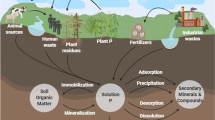Abstract
The binding capacities of surface waters for Cd, Cu, and Pb were determined for eight water samples representing four rivers and two swamps from Florida and Georgia in the southeastern United States The binding capacity ranges were CdBC=0 04 to 0 79 μg atm/L, CuBC=1 0 to 5 4 μg atm/L, and PbBC=5 0 to 17 8 μg atm/L Binding capacity values from the southeastern United States are shown to be in good agreement with values reported from the northeastern part of the country and northern Europe The CdBC was due primarily to inorganic ligand binding, while PbBC was predominantly a result of organic matter The CuBC was due to a complex function of both organic and inorganic binding Significant portions of the CuBC and PbBC could be removed from the waters by ultrafiltration of particles between 0·45 μm and 52 Å in diameter Ultrafiltration, even to removing particles > 13 Å diameter, did not affect the CdBC Distributional studies of the dissolved organic carbon in these systems reveal that significant fractions of the DOC are present in the ultrafilterable fraction which contains significant portions of the CuBC and PbBC
Similar content being viewed by others
References Cited
Alberts J. J., and D. W. Evans, 1979, Comparative chemistry of submicron sized organic fractions in four rivers of the southeastern United States: Prog. Phys. Chem. Earth, v. 12, p. 463–468.
Alberts, J. J., and B. J. Collins, 1980, Consequences of anaerobiosis on metal-organic interactions in two ponds of the southeastern United States, in Trudinger, P. A., M. R. Walter, and B. J. Ralph, (eds.), Biogeochemistry of Ancient and Modern Environments: Australian Academy of Science, p. 365–372.
American Public Health Association, 1976, Standard methods for the examination of water and wastewater, 14th ed., 1193 p.
Bauman, E. W., 1976, Nephelometric determination of microgram quantities of sulfate with 2-aminoperimidine: Savannah River Laboratory, ERDA, DP-1437, 17 p.
Beck, K. C., J. H. Reuter, and E. M. Perdue, 1974, Organic and inorganic geochemistry of some coastal plain rivers of the southeastern United States: Geochim. Cosmochim. Acta, v. 38, p. 341–364.
Forstner, U., and G. T. W. Wittmann, 1981, Metal Pollution in the Aquatic Environment, 2nd ed.: New York, Springer-Verlag, 486 p.
Giesy, Jr., J. P., and L. A. Briese, 1977, Metals associated with organic carbon extracted from Okefenokee Swamp water. Chem. Geol., v. 20, p. 109–120.
Giesy, Jr., J. P., L. A. Briese, and G. J. Leversee, 1978, Metal binding capacity of selected Maine surface waters: Environ. Geol., v. 2, p. 257–268.
Giesy, Jr., J. P., and L. A. Briese, 1980, Metal binding capacity of northern Europe surface waters for Cd, Cu, and Pb: Org. Geochem., v. 2, p. 57–67.
Helwig, J. T., and K. A. Council, 1979, SAS User’s Guide: Raleigh, N.C., SAS Institute, 494 p.
Jenne, E. A., (ed.), 1979, Chemical Modeling in Aqueous Systems Speciation, Sorption, Solubility, and Kinetics: ACS Symposium Series 93, 914 p.
Morrison, D. F., 1976, Multivariate Statistical Analysis: New York, McGraw-Hill, 338 p.
Neubecker, T. A., and H. E. Allen, 1983, The measurement of complexation capacity and conditional stability constants for ligands in natural waters: Water Res., v. 17, p. 1–14.
Reuter, J. H., and E. M. Perdue, 1977, Importance of heavy metal-organic matter interactions in natural waters: Geochim. Cosmochim. Acta, v. 41, p. 325–334.
Schindler, J. E., and J. J. Alberts, 1974, Analysis of organic-inorganic associations of four Georgia reservoirs: Arch. Hydrobiol., v. 74, p. 429–440.
Stumm, W., and J. J. Morgan, 1981, Aquatic Chemistry—An Introduction Emphasizing Chemical Equalibrium in Natural Waters: New York, John Wiley & Sons, 780 p.
Truitt, R. E., and J. H. Weber, 1981, Copper (II)- and cadmium (II)-binding abilities of some New Hampshire freshwaters determined by dialysis titration: Environ. Sci. Technol., v. 15, p. 1204–1208.
Tuschall, Jr., J. R., and P. L. Brezonik, 1983, Complexation of heavy metals by aquatic humus: A comparative study of five analytical methods, in Christman, R. F., and E. T. Gjessing, (eds.), Aquatic and Terrestrial Humic Materials: Ann Arbor, Mich., Ann Arbor Science, p. 275–294.
Weber, J. H., 1983, Metal ion speciation studies in the presence of humic materials, in Christman, R. F., and E. T. Gjessing, (eds.), Aquatic and Terrestrial Humic Materials: Ann Arbor, Mich., Ann Arbor Science, p. 315–331.
Wershaw, R. L., and D. J. Pinckney, 1971, Association and dissociation of a humic acid fraction as a function of pH: U.S. Geol. Survey Prof. Paper, 750-D, p. D216–D218.
Wilson, D. E., 1978, An equilibrium model describing the influence of humic materials on the speciation of Cu+2, Zn+2, and Mn+2 in freshwaters: Limnol. Oceanog., v. 23, p. 499–507.
Author information
Authors and Affiliations
Rights and permissions
About this article
Cite this article
Alberts, J.J., Giesy, J.P. & Evans, D.W. Distribution of dissolved organic carbon and metal-binding capacity among ultrafilterable fractions isolated from selected surface waters of the southeastern United States. Environ. Geol. Water Sci 6, 91–101 (1984). https://doi.org/10.1007/BF02509915
Issue Date:
DOI: https://doi.org/10.1007/BF02509915




